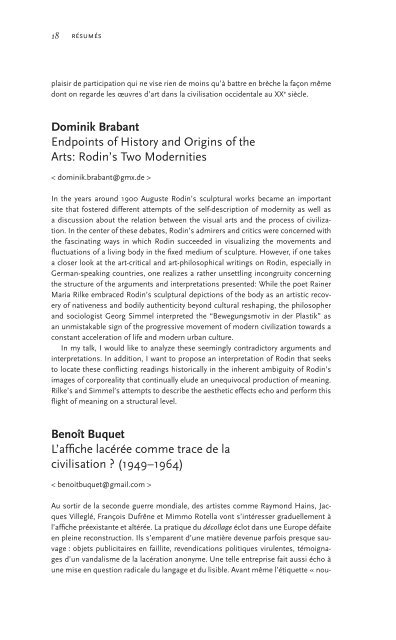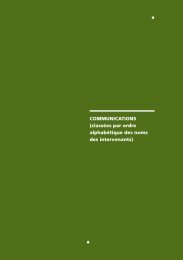Programme et Abstracts (PDF) - Réseau International pour la ...
Programme et Abstracts (PDF) - Réseau International pour la ...
Programme et Abstracts (PDF) - Réseau International pour la ...
Create successful ePaper yourself
Turn your PDF publications into a flip-book with our unique Google optimized e-Paper software.
18<br />
résumés<br />
p<strong>la</strong>isir de participation qui ne vise rien de moins qu’à battre en brèche <strong>la</strong> façon même<br />
dont on regarde les œuvres d’art dans <strong>la</strong> civilisation occidentale au XX e siècle.<br />
Dominik Brabant<br />
Endpoints of History and Origins of the<br />
Arts: Rodin’s Two Modernities<br />
< dominik.brabant@gmx.de ><br />
In the years around 1900 Auguste Rodin’s sculptural works became an important<br />
site that fostered different attempts of the self-description of modernity as well as<br />
a discussion about the re<strong>la</strong>tion b<strong>et</strong>ween the visual arts and the process of civilization.<br />
In the center of these debates, Rodin’s admirers and critics were concerned with<br />
the fascinating ways in which Rodin succeeded in visualizing the movements and<br />
fluctuations of a living body in the fixed medium of sculpture. However, if one takes<br />
a closer look at the art-critical and art-philosophical writings on Rodin, especially in<br />
German-speaking countries, one realizes a rather uns<strong>et</strong>tling incongruity concerning<br />
the structure of the arguments and interpr<strong>et</strong>ations presented: While the po<strong>et</strong> Rainer<br />
Maria Rilke embraced Rodin’s sculptural depictions of the body as an artistic recovery<br />
of nativeness and bodily authenticity beyond cultural reshaping, the philosopher<br />
and sociologist Georg Simmel interpr<strong>et</strong>ed the “Bewegungsmotiv in der P<strong>la</strong>stik” as<br />
an unmistakable sign of the progressive movement of modern civilization towards a<br />
constant acceleration of life and modern urban culture.<br />
In my talk, I would like to analyze these seemingly contradictory arguments and<br />
interpr<strong>et</strong>ations. In addition, I want to propose an interpr<strong>et</strong>ation of Rodin that seeks<br />
to locate these conflicting readings historically in the inherent ambiguity of Rodin’s<br />
images of corporeality that continually elude an unequivocal production of meaning.<br />
Rilke’s and Simmel’s attempts to describe the aesth<strong>et</strong>ic effects echo and perform this<br />
flight of meaning on a structural level.<br />
Benoît Buqu<strong>et</strong><br />
L’affiche <strong>la</strong>cérée comme trace de <strong>la</strong><br />
civilisation ? (1949–1964)<br />
< benoitbuqu<strong>et</strong>@gmail.com ><br />
Au sortir de <strong>la</strong> seconde guerre mondiale, des artistes comme Raymond Hains, Jacques<br />
Villeglé, François Dufrêne <strong>et</strong> Mimmo Rotel<strong>la</strong> vont s’intéresser graduellement à<br />
l’affiche préexistante <strong>et</strong> altérée. La pratique du décol<strong>la</strong>ge éclot dans une Europe défaite<br />
en pleine reconstruction. Ils s’emparent d’une matière devenue parfois presque sauvage<br />
: obj<strong>et</strong>s publicitaires en faillite, revendications politiques virulentes, témoignages<br />
d’un vandalisme de <strong>la</strong> <strong>la</strong>cération anonyme. Une telle entreprise fait aussi écho à<br />
une mise en question radicale du <strong>la</strong>ngage <strong>et</strong> du lisible. Avant même l’étiqu<strong>et</strong>te « nou-<br />
veau réalisme », l’affichisme en art se situe au confluent de <strong>la</strong> peinture abstraite, <strong>la</strong><br />
poésie l<strong>et</strong>triste, <strong>la</strong> photographie, le cinéma <strong>et</strong> entr<strong>et</strong>ient une position ambiguë envers<br />
<strong>la</strong> notion de ready made. L’intervention propose de réfléchir les rapports entre art <strong>et</strong><br />
civilisation au travers de l’affiche <strong>la</strong>cérée — entre déception <strong>et</strong> promesse, destruction<br />
<strong>et</strong> régénération — en revenant sur trois temps forts. Les fragments préparatoires <strong>et</strong><br />
résidus filmiques de l’un des premiers travaux de Hains <strong>et</strong> Villeglé, œuvre inachevée<br />
datée de 1949 <strong>et</strong> jamais commentée, posent <strong>la</strong> question de <strong>la</strong> trace de <strong>la</strong> civilisation<br />
<strong>et</strong> de sa disparition. L’exposition <strong>la</strong> France Déchirée de 1961 rappelle que le décol<strong>la</strong>ge<br />
s’inscrit <strong>et</strong> se systématise en pleine guerre d’Algérie, au moment où <strong>la</strong> France doit<br />
faire face à <strong>la</strong> question coloniale <strong>et</strong> où l’idéologie d’une « mission civilisatrice » ne<br />
devient plus tenable. Nous terminerons sur <strong>la</strong> biennale de Venise de 1964. Rotel<strong>la</strong><br />
expose officiellement au sein du pavillon italien <strong>et</strong> les travaux de Hains interrogent<br />
les spécificités d’une telle manifestation.<br />
Geoffrey Carr<br />
The Indian Residential School: Forging the<br />
“Chain b<strong>et</strong>ween Barbarism and Civilization”<br />
< gpccarr@interchange.ubc.ca ><br />
résumés 19<br />
In 1913, in his annual report to the Department of Indian Affairs, Indian Agent W.<br />
M. Halliday referred to each generation of Aboriginals that had attended residential<br />
school as a link in the “chain b<strong>et</strong>ween barbarism and civilization.” Halliday and<br />
many others in the Department at that time believed that a purpose-built structure,<br />
the residential school, would produce a comprador c<strong>la</strong>ss of ex-students who would<br />
r<strong>et</strong>urn to their home communities and hasten there the dissolution of cultural, social<br />
and economic n<strong>et</strong>works. Architectural p<strong>la</strong>ns for these institutions reveal overwrought<br />
spaces drawn to segregate gender, control movement and comportment, compel <strong>la</strong>bour,<br />
inculcate faith and facilitate surveil<strong>la</strong>nce. In this paper, I examine how notions<br />
of civilization, hygiene and discipline informed the design of this national n<strong>et</strong>work of<br />
schools and how these structures fit into a <strong>la</strong>rger typology of other institutions meant<br />
to produce civil space by controlling “difficult popu<strong>la</strong>tions.”<br />
I also survey the contemporary reuse of certain residential schools in British<br />
Columbia—for purposes as disparate as a luxury resort, a Roman Catholic pilgrimage<br />
site, a museum and a site of ceremonial destruction—to argue that these p<strong>la</strong>ces<br />
reflect complicated, unassimi<strong>la</strong>ble histories that cannot easily be sublimated by<br />
reconciliation efforts, such as financial reparations, memorials or official apologies.<br />
The popu<strong>la</strong>r, facile sentiment to “turn the page” on this painful history appears<br />
inadequate when confronted by the sheer geographic and temporal scope of the<br />
system’s built fabric. In this way, the narrative structure of “forgive and forg<strong>et</strong>,” of<br />
“turning the page” threatens to foreclose a Canadian Vergangenheitsbewaltigung, an<br />
unflinching struggle with this building type and with our colonial past.



